Translate this page into:
Protein-protein interaction of LDH and CRP-1 with hematotoxin snake venom proteins of all species of snake: An in silico approach
Address for correspondence: Dr. Prachi P. Parvatikar, Laboratory of Vascular Physiology and Medicine, Department of Physiology, BLDE (Deemed to be University), Vijayapur, Karnataka, India, Allied Health Sciences, BLDE (DU), Vijayapur, Karnataka, India. Tel: +91 8352 262770 (Extension 2262). E-mail: prachi.parvatikar@bldedu.ac.in
This is an open-access article distributed under the terms of the Creative Commons Attribution-Noncommercial-Share Alike 3.0 Unported, which permits unrestricted use, distribution, and reproduction in any medium, provided the original work is properly cited.
This article was originally published by Qassim Uninversity and was migrated to Scientific Scholar after the change of Publisher.
Abstract
Objective:
Snake bite-induced elevation of serum LDH and CRP-1 is considered as useful biomarkers of hemotoxic. The snake venom contains proteins and may result in various envenomation such as bleeding, inflammation, and pain, cytotoxic, cardiotoxic, or neurotoxic effects. This in silico study was aimed to screen the snake venom proteins and to find out the most interactive hemotoxic venom protein against LDH and CRP-1 proteins as biomarkers.
Materials and Methods:
To validate the hypothesis of the prospective interaction of snake venom proteins, molecular docking analysis was used in the current work by deploying a cutting-edge docking program. Snake venom peptides were screened from literature and both peptide as well as target protein were obtained from PDB. HDOCK online server was used for the molecular docking analysis of target proteins with hemotoxic snake venom peptides. Further, the toxicity properties of each docked complex of target proteins were subjected for ADME/T analysis.
Results:
The selected snake venom peptides were subjected to molecular docking study and the results generated from computational-based approach reveals that all the hematotoxin snake venom proteins are interactive with LDH and CRP-1 peptide. Further, this study indicates that snake venom metalloproteinase (SVMPS) peptide may be considered as the best interactive protein with both LDH and CRP-1 proteins; also, ADME/T screening revealed that all docked complex are safe and follow toxicity properties.
Conclusion:
This in silico study clearly shows that the greatest interaction of SVMPS peptide with LDH and CRP-1 may be due to strong binding in the active site of the target proteins LDH and CRP-1 with SVMPS. Results, further, confirmed LDH and CRP-1 as potential biomarkers against hemotoxic snake venoms. This study should be validated by in vitro and in vivo analysis as well as specific species snake venom should be assessed. For further studies, SVMPS can be consider as therapeutic point of view.
Keywords
C-reactive protein
hematotoxin snake venom proteins
lactate dehydrogenase
snake venom metalloproteinase
Introduction
Snake venoms are natural sources of physiologically active chemicals that can modulate physiological activities by acting selectively and specifically on diverse cellular targets.[1] Snake venom is complex mixtures, which constituted of proteins and peptides, given ample and demanding opportunities, as well as a diverse molecular architecture, for the design and development of instruments and agents of scientific and therapeutic interest.[2]
The use of biomarkers in basic and clinical research as well as in clinical practice has become so commonplace that their presence as primary endpoints in clinical trials is now accepted almost without question. In recent year, biomarkers play important role in understanding information on complex cascade of events and molecular mechanisms underlying.[3,4] The biomarkers have the potential to improve diagnostic accuracy, predict clinical outcomes, select patients for clinical trials, track disease progression, and find new treatment targets.[5]
The search for newer and sensitive biochemical markers for systemic envenomation is a field of active ongoing research. Serum LDH and CRP-1 activities increased in mild-to-severe envenomation cases; hence, it may be useful as biomarker in the diagnosis and prognosis of snake bite cases.[6,7]
The present study was aimed to assess the interactions of LDH and CRP-1 as predictor biomarker proteins with hemotoxic snake venom proteins using molecular docking and in silico ADME studies. Further, this in silico study will also predict the most interactive protein among the hemotoxic snake venom proteins.
Methodology
Screening of snake venom peptides from database and literature
For this proposed study, all types of snake venom, that is, hematoxic, cytotoxic, neurotoxic, and proteolytic were screened from literature. Further, only hemotoxic snake venom protein was selected for further process.
Retrieval of selected peptides from PDB database
The available 3-D structure of selected hematoxic peptides was retrieved from protein data bank (PDB). The 3-D structure of selected hematoxic peptides were retrieved from protein data bank (PDB) [Table 1].

Retrieval of target proteins sequences
The crystal structure of human LDH (PDBID: 4I9U) and CRP-1(PDBID:1PVN) protein were obtained from the Brookhaven protein data bank.[8] The protein structures were processed using accerly discovery studio by removing all non-receptor atoms including water, ion, and miscellaneous compounds. The binding site for the inhibitor was searched based on a structural association of template with experimental evidence using PDBsum supported by a literature survey [Figure 1].[9]
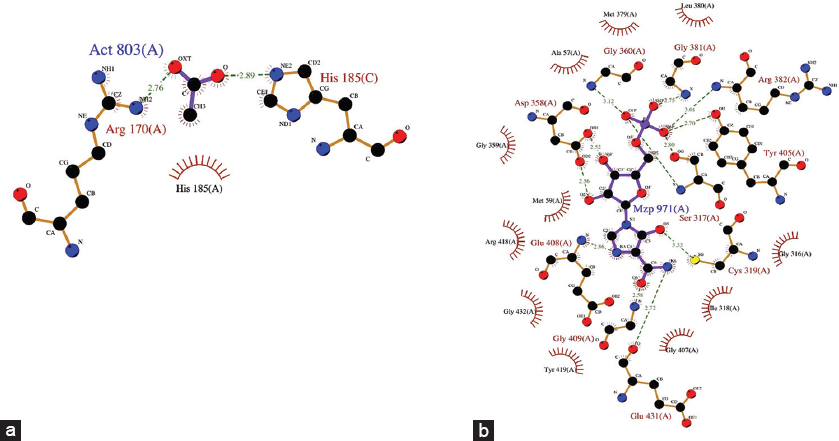
- Binding site of target protein (a) human LDH and (b) human CRP-1
Docking studies
Protein-protein interaction is important to understand many biological processes such as metabolic pathways and protein regulations. To gain structural insight into interaction of LDH and CRP-1 protein with snake venom peptides, the protein- protein docking was performed. The protein-protein interaction was predicted in HDOCK server (http://hdock.phys.hust.edu.cn/).[10] It is an integrated tool of multiple function such as homology search, template-based modeling, structure prediction, and macromolecular docking with comprehensible approach. This online server takes both sequences and structures as an input. The intrinsic scoring functions are used to predict the protein–protein and protein–DNA/RNA docking. The HDOCK score include van der Waals, electrostatic, and restraint violation energies. The interaction between target proteins and snake venom peptides was visualized through discovery studio.
Screening of ADME/T properties by SWISS-ADMET online tool
All the docked the complex were subjected to ADME/T screening in SWISS ADMET tool, it was predicted that all the complex obey Lipinski rule and safe.[11]
Results
Screening of snake venom peptides from database and literature
From the literature, hemotoxin snake venom peptides were screened and among them seven were further selected. This toxin is predominantly found in many vipers, cobra, and rattlesnakes. The toxin causes hemolysis by destruction of red blood cells or cause blood coagulation. Snake venom metalloproteinase (SVMPS) is common venom peptide found in hemotoxin.
Table 1 and Figure 2 showed some selected snake venom peptides with PDBID from specific snake species as found in protein database.[12]
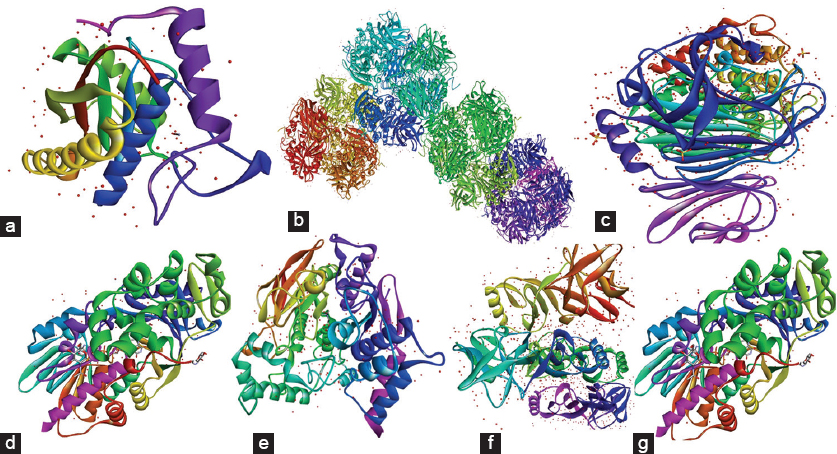
- 3-D structure of hemotoxic snake venom peptides (a) snake venom metalloproteinase (SVMPS); (b) arginine ester hydrolases; (c) hyaluronidases; (d) phospholipases A2 (PLA2s); (e) acetylcholinesterase (AChE); and (f) serine proteinase (SvsPs);G) L-amino acid oxidase (LAAO)
Retrieval of target proteins from PDB database
The crystal structure of both target proteins complexed with the inhibitor is already reported. The human LDH is composed of 507 amino acids, with a molecular weight of 299.3 kDa and resolution of 2.30 Å. This protein has single domains (62-265) and two amino acid residues in active site Arg170, His 185. Human CRP-1 protein has 224 amino acid residues in A chain with 1.98 Å. It also has only one conserved domain, Cys319, Asp358, Gly360, Gly381, Arg382, Tyr405, Gly408, and Gly409 amino acid residues in binding domain [Figures 1 and 3].
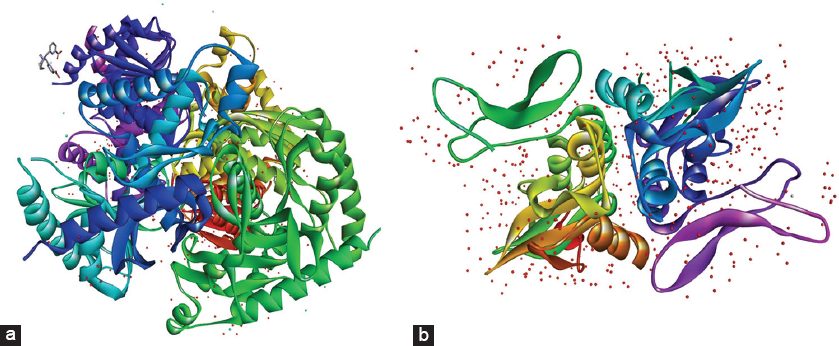
- 3-D structure of target protein with PDB ID (a) human LDH (PDBID: 4I9U) and (b) human CRP-1 (PDBID:1PVN)
Docking studies
Molecular docking shows the best binding confirmation and predicts low confirmation energy. Intrinsic scoring function was used to select the best complex among the selected best protein-peptide complex. The server predicted that all the selected snake venom peptide exhibited good activity, among all the snake venom metalloproteinase (SVMPS) exhibited the best affinity with the active binding site of both target proteins. The binding energy for LDH-SVMPS is – 256.54 kJ/mol and CRP-1-SVMPS is –234.15 kJ/mol [Table 2 and Figure 4].

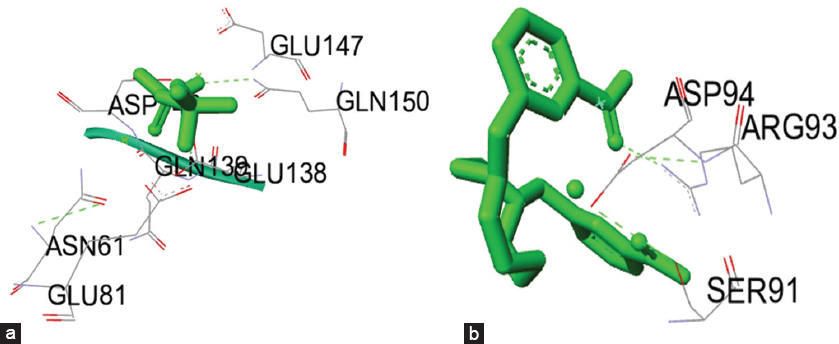
- Molecular interaction of snake venom metalloproteinase with (a) LDH and (b) CRP-1
Screening of ADME/T properties by SWISS-ADMET online tool
ADME/T analysis of all docked complex predicted for various pharmacological properties using SWISS ADME software. All docked complex of both target proteins follows the Lipinski rule of five. There is zero violation of the rule shown by these molecules. The compounds exceeding the cutoff values tend to have solubility and permeability problems which would lead to poor oral bioavailability; hence, these molecules are eliminated. The property of selected drug molecules is depicted in the [Table 3].
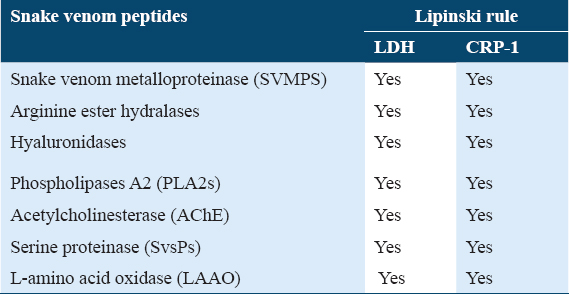
Discussion
Snake venom protein composed of various components.[13] Venom is complex mixtures of proteinaceous components (circa 50–200). Through a variety of processes, including gene duplication, recombination, and straightforward expression modification, these toxins have evolved from a number of non-toxic housekeeping genes. Snake venoms can be broadly classified as hemotoxic, neurotoxic or cytotoxic. When a person is bitten by a snake, the hemorrhagic, coagulopathic, and/or hypotensive pathologies caused by the snake venom hemotoxins can develop. Therefore, improving our knowledge of the bioactivity of venom hemotoxins is crucial for the development of next-generation anti-venom therapies. Due to their high levels of selectivity and potency, venom hemotoxins continue to be highly relevant for use as investigational ligands for understanding vertebrate physiology as well as for the development of new therapeutic and diagnostic pharmaceuticals relevant for human medicine. In past few years, computer-aided drug discovery has emerged as an effective and promising tool for new drug discovery using existing drug database. The in silico drug discovery approach has already been employed in various diseases. There are many reports which suggest that form ancient time in Ayurveda, homeopathy snake venom is used in different pathophysiological conditions.[14] CRP has been used in several studies as the prototypic biomarker of inflammation.[15] From the research reports, snake venoms can be consider as important source for new drug discovery. Many snake venom components such as PLA, serine proteases, metalloproteinase, lectins, l-amino-acid oxidases, bradykinin potentiating factors, natriuretic factors, and integrin induce some pharmacological actions which include neurotoxicity, myotoxicity, cytotoxicity, hemotoxic, and antimicrobial activity.[16]
Some reports suggested role of serum LDH and CRP as markers of hemolysis. Venomous snakebites by developing acute phase reaction characterized with pathophysiological changes such as moderate leukocytosis, with neutrophilia, lymphopenia, and eosinophilia along with increase of LDH and C-reactive protein and decrease of total proteins, erythrocyte sedimentation rate, and albumin.[17] Results from this in silico study are suggestive of the potential utility of serum LDH and CRP-1 activities as possible useful biomarkers in the diagnosis and prognosis of snake bite cases.[18] Snake bite-induced increase in LDH is indicative of as a result of hemolysis which further leads to acute renal failure.[19] It also induces inflammatory responses in the vascular smooth muscles and alter CRP level. Reports suggests that hematological analysis of snake bite showed positive elevated CRP level.[20]
The aim behind selection of hemotoxin peptides was the many vipers and cobra species are dominant in the North Karnataka region as well as its prediction of interaction with target proteins as biomarker. This in silico study revealed that snake venom metalloproteinases (SVMPs) docks both LDH and CRP with the best affinities among all the types of hemotoxic snake venom proteins.
The SVMPs cause local and systemic effects including hemorrhage, myonecrosis, blistering, dermonecrosis, edema, and coagulopathies, in addition to being allogenic and strongly pro-inflammatory. Hence, this hemotoxic snake venom proteins SVMPs may be considered as the best possible biomarker of hemotoxic snake bite induced and can be used as diagnostic and prognostic tool for snake bite injuries.
Conclusion
The current work suggests that both target proteins, that is, LDH and CRP positively interact with SVMPs as bind with amino acid residues in the active site of target proteins and are likely to be effective biomarker in snake bite patients. These molecules mimic the substrate structure and have a nearly identical affinity for the binding site, thus negating the enzyme action. Hence, further study should carry out to on SVMP activity as therapeutic point of view. This study should be validated by in vitro and in vivo analysis as well as specific species snake venom should be assessed.
Authors Declaration
Ethics approval and consent to participate
The study is completely based on in silico approach so no humans are involved in it.
Availability of data and material
The data that support the findings of this study are available from the corresponding author on reasonable request.
Competing Interest
The author has no conflicts of interest to declare.
Funding Statement
Present study has not received any funding.
Author Contribution
-
Rajesh M. Honutagi: Concept design
-
R. Sunil: Review of literature
-
S. M. Patil: Review of literature
-
Supriya Bhosale: Data Collection
-
Swastika N. Das: Manuscript writing
-
Prachi P. Parvatikar: Data exicution, data analysis & Manuscript writing
-
Kusal K. Das: Manuscript proof reading.
Acknowledgements
Not applicable.
References
- Snake venom toxins:Toxicity and medicinal applications. Appl Microbiol Biotechnol. 2016;100:6165-81.
- [Google Scholar]
- Proteome analysis of snake venom toxins:Pharmacological insights. Expert Rev Proteomics. 2008;5:787-97.
- [Google Scholar]
- Therapeutic efficacy of anfibatide in a murine model of thrombotic thrombocytopenic purpura (TTP) Ame J Clin Patho. 2017;147:S153.
- [Google Scholar]
- Innovative therapeutics:Designer natriuretic peptides. JACC Bas Transl Sci. 2016;1:557-67.
- [Google Scholar]
- Discovery Studio. United States: Accelrys; 2008.
- HDOCK:A web server for protein-protein and protein-DNA/RNA docking based on a hybrid strategy. Nucleic Acids Res. 2017;45:W365-73.
- [Google Scholar]
- Venoms to Drugs:Venom as a Source for the Development of Human Therapeutics. United Kingdom: Royal Society of Chemistry (RSC) Publishing; 2015.
- Snake venom variability:Methods of study, results and interpretation. Toxicon. 1991;29:1279-303.
- [Google Scholar]
- Should we teach computational thinking and big data principles to medical students? Int J Health Sci (Qassim). 2019;13:1-2.
- [Google Scholar]
- A comprehensive view of the structural and functional alterations of extracellular matrix by snake venom metalloproteinases (SVMPs):Novel perspectives on the pathophysiology of envenoming. Toxins (Basel). 2016;8:304.
- [Google Scholar]
- Protective potential of vitamin E against methylphenidate-induced male gonadal changes in albino rats. Int J Health Sci (Qassim). 2019;13:19-23.
- [Google Scholar]
- De novo sequencing and transcriptome analysis for Tetramorium bicarinatum:A comprehensive venom gland transcriptome analysis from an ant species. BMC Genomics. 2014;15:987.
- [Google Scholar]
- Venom gland transcriptomics for identifying, cataloging, and characterizing venom proteins in snakes. Toxicon. 2015;93:1-10.
- [Google Scholar]
- Assessment of cardiac biomarkers (troponin, B-Type natriuretic peptide, and D-dimer) in patients with non-valvular atrial fibrillation and stroke Int J Health Sci (Qassim). 2019;13:3-12.
- The potential influence of hyperthyroidism on circulating adipokines chemerin, visfatin, and omentin. Int J Health Sci (Qassim). 2019;13:44-7.
- [Google Scholar]







